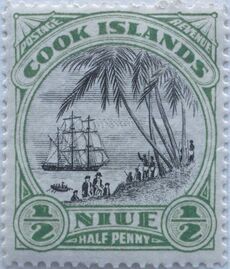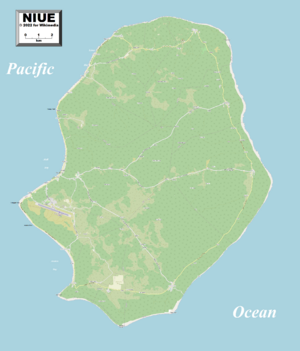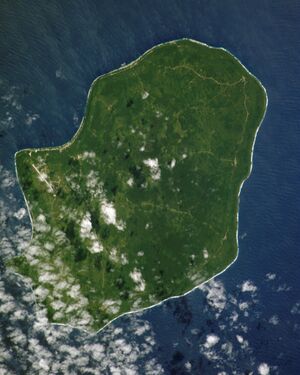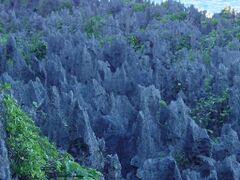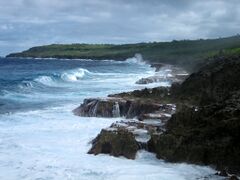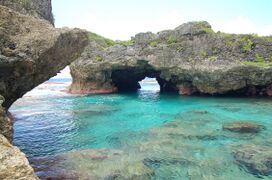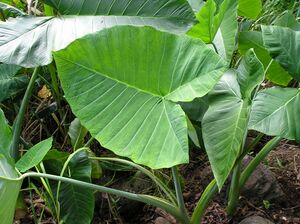نيووِيْ
نيووِيْ Niuē (Niuean) | |
|---|---|
الشعار الحادي: Atua, Niue Tukulagi | |
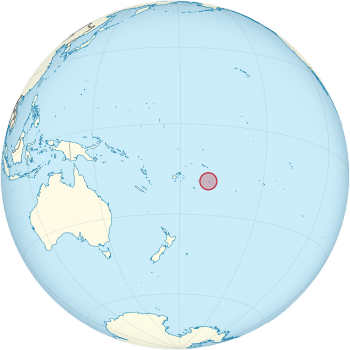 | |
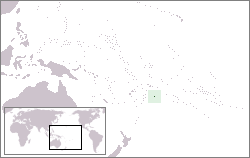 موقع نيووِيْ في غرب المحيط الهادي. | |
| العاصمة | ألوفي 19°03′14″S 169°55′12″W / 19.05389°S 169.92000°W |
| أكبر أكبر مدينة | العاصمة |
| اللغات الرسمية | |
| الجماعات العرقية |
|
| الدين | |
| صفة المواطن | نيووِيْ |
| الحكومة | ملكيةدستورية برلمانية مركزية غير حزبية |
• Monarch | قالب:Monarch of New Zealand, current |
• [[Governor-General of New Zealand|Representative of the قالب:Monarch of New Zealand, current]][أ] | Dame Cindy Kiro |
• Premier | Dalton Tagelagi |
| التشريع | Niue Assembly |
| Associated state of New Zealand | |
• Self-government in free association with New Zealand | 19 October 1974 |
| 1994 | |
| المساحة | |
• الإجمالية | 261.46[5] km2 (100.95 sq mi) |
• الماء (%) | ضئيلة |
| التعداد | |
• تقدير 2016 | 1,624[6] (not ranked) |
• إحصاء 2017 | 1,784[7] |
• الكثافة | 6.71/km2 (17.4/sq mi) (not ranked) |
| ن.م.إ. (ق.ش.م.) | تقدير 2003 |
• الإجمالي | $10.0 million[8] (رقم 228) |
• للفرد | $5,800[9] (164th) |
| ن.م.إ. (الإسمي) | تقدير 2018 |
• الإجمالي | ▲ NZ$43.536 million (US$30,510,028)[10] |
| العملة | New Zealand dollar[a] (NZD) |
| التوقيت | UTC−11 |
| جانب السواقة | left |
| مفتاح الهاتف | +683 |
| النطاق العلوي للإنترنت | .nu |
| |
نيووِيْ ( /ˈnjuːeɪ/،[11] /niːˈjuːeɪ/; Niuean: Niuē) هي بلد جزيرة تقع في جنوب المحيط الهادي، على بعد 2400 كم شمال شرق نيوزيلندا. تبلغ مساحة البر في نيووِيْ 261 كم² تقريباً[5] وبلغ عدد سكانها عام 2016، معظمهم من الپولينيزيين، قرابة 1.600. تقع نيووِيْ في مثلث بين تونگا وساموا وجزر كوك. تقع نيووِيْ على بعد 604 كم شمال تونگا. تشتهر الجزيرة باسم "الصخرة"، المشتق من اسمها التقليدي "صخرة پولينيزيا".[12] وتعتبر نيووِيْ واحدة من أكبر الجزر المرجانية في العالم. Niue is located in a triangle between Tonga, Samoa, and the Cook Islands. It is 604 kilometres northeast of Tonga. The island is commonly referred to as "The Rock", which comes from the traditional name "Rock of Polynesia".[13] Niue is one of the world's largest coral islands. The terrain of the island has two noticeable levels. The higher level is made up of a limestone cliff running along the coast, with a plateau in the centre of the island reaching approximately 60 metres (200 feet) above sea level. The lower level is a coastal terrace approximately 0.5 km (0.3 miles) wide and about 25–27 metres (80–90 feet) high, which slopes down and meets the sea in small cliffs. A coral reef surrounds the island, with the only major break in the reef being in the central western coast, close to the capital, Alofi.
Niue is a self-governing state in free association with New Zealand, and New Zealand conducts most diplomatic relations on its behalf. As part of the Realm of New Zealand, Niueans are citizens of New Zealand and Charles III is Niue's head of state in his capacity as King of New Zealand. Between 90% and 95% of Niuean people live in New Zealand,[14] along with about 70% of the speakers of the Niuean language.[15] Niue is a bilingual country, with 30% of the population speaking both Niuean and English. The percentage of monolingual English-speaking people is only 11%, while 46% are monolingual Niuean speakers.
Niue is not a member of the United Nations (UN), but UN organisations have accepted its status as a freely associated state as equivalent to independence for the purposes of international law.[16] As such, Niue is a member of some UN specialised agencies (such as UNESCO[17] and the WHO),[18] and is invited, alongside the other non-UN member state, the Cook Islands, to attend United Nations conferences open to "all states".[19] Niue has been a member of the Pacific Community since 1980.
Niue is subdivided into 14 villages (municipalities). Each village has a council that elects its chairperson. The villages are at the same time electoral districts; each village sends an assemblyperson to the Niue Assembly (parliament).[20] A small and democratic nation, Niueans hold legislative elections every three years.
التاريخ
Polynesians from Samoa settled Niue around 900 AD. Further settlers arrived from Tonga in the 16th century.[21]
Until the beginning of the 18th century, Niue appears to have had no national government or national leader; chiefs and heads of families exercised authority over segments of the population. A succession of patu-iki (kings) ruled, beginning with Puni-mata. Tui-toga, who reigned from 1875 to 1887, was the first Christian king.[22]
The first Europeans to sight Niue sailed under Captain James Cook in 1774. Cook made three attempts to land, but the inhabitants refused to grant permission to do so. He named the island "Savage Island" because, as legend has it, the natives who "greeted" him were painted in what appeared to be blood. The substance on their teeth was hulahula, a native red fe'i banana.[23] For the next couple of centuries, Niue was known as Savage Island until its original name, "Niue", which translates as "behold the coconut",[24] regained use.
Whaling vessels were some of the most regular visitors to the island in the nineteenth century. The first on record was the Fanny in February 1824. The last known whaler to visit was the Albatross in November 1899.[25]
The next notable European visitors represented the London Missionary Society; they arrived on the Messenger of Peace. After many years of trying to land a European missionary, they abducted a Niuean named Nukai Peniamina and trained him as a pastor at the Malua Theological College in Samoa.[26] Peniamina returned in 1846 on the John Williams as a missionary with the help of Toimata Fakafitifonua. He was finally allowed to land in Uluvehi Mutalau after a number of attempts in other villages had failed. The chiefs of Mutalau village allowed him to land and assigned over 60 warriors to protect him day and night at the fort in Fupiu.
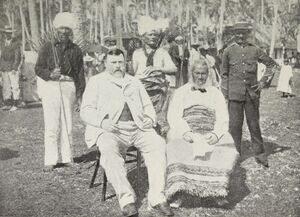
الحكومة والسياسة
الدفاع والشئون الخارجية
الجغرافيا
المناخ
| أخفClimate data for ألوفي | |||||||||||||
|---|---|---|---|---|---|---|---|---|---|---|---|---|---|
| Month | Jan | Feb | Mar | Apr | May | Jun | Jul | Aug | Sep | Oct | Nov | Dec | Year |
| Record high °C (°F) | 38 (100) |
38 (100) |
32 (90) |
36 (97) |
30 (86) |
32 (90) |
35 (95) |
37 (99) |
36 (97) |
31 (88) |
37 (99) |
36 (97) |
38 (100) |
| Mean daily maximum °C (°F) | 28 (82) |
29 (84) |
28 (82) |
27 (81) |
26 (79) |
26 (79) |
25 (77) |
25 (77) |
26 (79) |
26 (79) |
27 (81) |
28 (82) |
27 (81) |
| Daily mean °C (°F) | 26 (79) |
27 (81) |
26 (79) |
25 (77) |
25 (77) |
23 (73) |
22 (72) |
23 (73) |
23 (73) |
24 (75) |
25 (77) |
26 (79) |
25 (77) |
| Mean daily minimum °C (°F) | 23 (73) |
24 (75) |
24 (75) |
23 (73) |
22 (72) |
21 (70) |
20 (68) |
20 (68) |
21 (70) |
21 (70) |
22 (72) |
23 (73) |
22 (72) |
| Record low °C (°F) | 20 (68) |
20 (68) |
20 (68) |
14 (57) |
15 (59) |
13 (55) |
11 (52) |
11 (52) |
15 (59) |
15 (59) |
11 (52) |
17 (63) |
11 (52) |
| Average precipitation mm (inches) | 261.6 (10.30) |
253.6 (9.98) |
305.6 (12.03) |
202.6 (7.98) |
138.2 (5.44) |
88.9 (3.50) |
96.4 (3.80) |
105.8 (4.17) |
102.4 (4.03) |
123.8 (4.87) |
145.5 (5.73) |
196.2 (7.72) |
2٬018٫4 (79.46) |
| Source: Weatherbase[27] | |||||||||||||
البيئة
الحياة النباتية والحيوانية
الاقتصاد
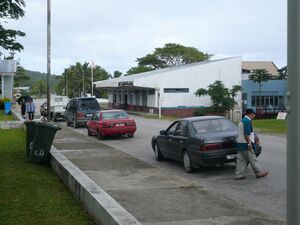
الزراعة
السياحة
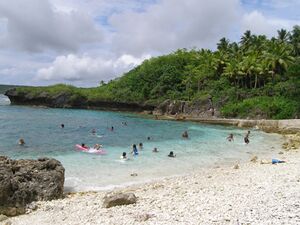
الملاحة الشراعية
الديون
تكنولوجيا المعلومات
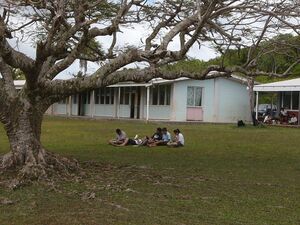
الديموغرافيا
السكان
| السنة | السكان |
|---|---|
| 1950 | 4.667 |
| 1960 | 4.830 |
| 1970 | 5.130 |
| 1980 | 3.402 |
| 1990 | 2.332 |
| 2000 | 1.900 |
| 2010 | 1.620 |
| 2017 | 1.618 |
الديانات
اللغات
الثقافة
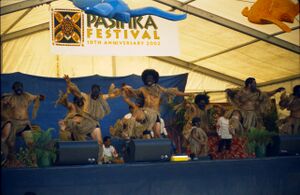
الإعلام
المتاحف
الرياضة

انظر أيضاً
الهوامش
- ^ The قالب:Monarch of New Zealand, current in right of New Zealand is represented by the Governor-General of New Zealand in relation to Niue.[2]
المصادر
- ^ "Religions in Niue | PEW-GRF". www.globalreligiousfutures.org.
- ^ "Niue National Strategic Plan 2016-2026" (PDF). Government of Niue. 2016. p. 35.
- ^ "The World today" (PDF). UN.
- ^ "Repertory of Practice – Organs Supplement" (PDF). UN. p. 10. Archived from the original (PDF) on 19 October 2013.
- ^ أ ب "Niue". GeoHive. Archived from the original on 6 October 2013. Retrieved 5 October 2013.
- ^ "World Population Prospects: The 2017 Revision". ESA.UN.org (custom data acquired via website). United Nations Department of Economic and Social Affairs, Population Division. Retrieved 10 September 2017.
- ^ "Niue Household and Population Census 2017" (PDF). niue.prism.spc.int. Niue Statistics Office. Retrieved 5 May 2020.
- ^ "The World Factbook – Central Intelligence Agency". www.cia.gov. Archived from the original on 4 June 2011. Retrieved 8 September 2017.
- ^ "The World Factbook – Central Intelligence Agency". www.cia.gov. Archived from the original on 24 April 2013. Retrieved 8 September 2017.
- ^ "Niue National Accounts estimates". niue.prism.spc.int. Niue Statistics Office. Retrieved 5 May 2020.
- ^ Deverson, Tony; Kennedy, Graeme, eds. (2005). "Niue". The New Zealand Oxford Dictionary. Oxford University Press. doi:10.1093/acref/9780195584516.001.0001. ISBN 978-0-19-558451-6. Retrieved 18 February 2022.
- ^ "Introducing Niue". Lonely Planet. Retrieved 24 October 2016.
- ^ "Introducing Niue". Lonely Planet. Retrieved 24 October 2016.
- ^ "QuickStats About Pacific Peoples". Statistics New Zealand. 2006. Archived from the original on 19 November 2011. Retrieved 28 October 2011.
- ^ Moseley, Christopher; R. E. Asher, eds. (1994). Atlas of the World's Languages. New York: Routledge. p. 100.
- ^ "Find a publication". New Zealand Ministry of Justice.
- ^ "Niue". UNESCO International Bureau of Education.
- ^ "List of member countries". World Health Organization. Archived from the original on 21 August 2004.
- ^ "Pacific Climate Change: Niue urges world leaders to leave legacy of action at climate conference". climatepasifika.blogspot.com.br. 8 December 2011.
- ^ "Niue Islands Village Council Ordinance 1967". Archived from the original on 28 December 2016. Retrieved 28 October 2017.
- ^ "Niue". Encyclopædia Britannica. 10 August 2015. Retrieved 17 January 2017.
- ^ Smith, S Percy (1903). "Niuē-fekai (or Savage) Island and its People". pp. 36–44.
- ^ Horowitz, Anthony 'Tony' (2002). "8". Blue Latitudes: Boldly Going Where Captain Cook Has Gone Before..
- ^ Marks, Kathy (9 July 2008). "World's smallest state aims to become the first smoke-free paradise island". The Independent. London. Archived from the original on 21 June 2022. Retrieved 21 July 2008.
- ^ Langdon, Robert (1984) Where the whalers went: an index to the Pacific ports visited by American whalers (and some other ships) in the 19th century, Canberra, Pacific Manuscripts Bureau, p.192-3. ISBN 086784471X
- ^ Juergensmeyer, Mark; Roof, Wade C., eds. (18 October 2011). "Nukai Peniamina". Encyclopedia of Global Religion. Sage Publishing. p. 925. ISBN 978-1452266565.
- ^ "Weatherbase: Historical Weather for Alofi, Niue". Weatherbase. Retrieved 3 August 2009.
قراءات إضافية
- Niue, the Pacific island struggling to cope as its population plummets
- Chapman, Terry M. (1976) – The Decolonisation of Niue.
- Hekau, Maihetoe & al., Niue: A History of the Island, Suva: Institute of Pacific Studies (USP) & the government of Niue, 1982 [no ISBN]
- Loeb, Edwin M. (1926) – History and Traditions of Niue.
- Painter, Margaret and Kalaisi Folau (2000) – Tagi Tote e Loto Haaku, My Heart Is Crying a Little: Niue Island Involvement in the Great War, 1914–1918.
- Smith, Percy – Niue-fekai (or Savage) Island and its People.
- Sperlich, Wolfgang B. (2012) – Tohi Vagahau Niue/Niue Language Dictionary: Niuean-English, with English-Niuean Finderlist.
- Thomson, Basil C. (2012) – Savage Island: An Account of a Sojourn in Niue and Tonga.
- James P Terry and Warwick E Murray (edited by) - Niue Island: Geographical Perspectives on the Rock of Polynesia International Scientific Council for Island Development (INSULA), UNESCO, ISBN 9299002304.
- SPREP, Rod Hay and Ralph Powlesland, Compiled by Joanna Sim –Guide to Birds of Niue
- Tregear, Edward, "Niue: or Savage Island", The Journal of the Polynesian Society, vol.2, March 1893, pp. 11–16
- W R Sykes – Contributions to the Flora of Niue
- Dick Scott (1993) – Would a Good Man Die
وصلات خارجية
- الحكومة
- Niuean Government official site
- معلومات عامة
- Niue. The World Factbook. Central Intelligence Agency.
- Niue from UCB Libraries GovPubs
- نيووِيْ at Curlie
 Wikimedia Atlas of Niue
Wikimedia Atlas of Niue
- السفر
- Short description is different from Wikidata
- Articles containing Niuean-language text
- Pages using gadget WikiMiniAtlas
- Pages using infobox country or infobox former country with the symbol caption or type parameters
- Pages using Lang-xx templates
- Articles with hatnote templates targeting a nonexistent page
- Articles with Curlie links
- دول اوقيانوسية
- نيووِيْ
- 1974 establishments in Oceania
- Associated states of New Zealand
- British Western Pacific Territories
- Countries in Polynesia
- بلدان وأراضي ناطقة بالإنگليزية
- Former British colonies and protectorates in Oceania
- بلدان جزر
- New Zealand–Pacific relations
- Populated places established in the 10th century
- Small Island Developing States
- States and territories established in 1974
- Countries in Oceania
- Important Bird Areas of Niue


